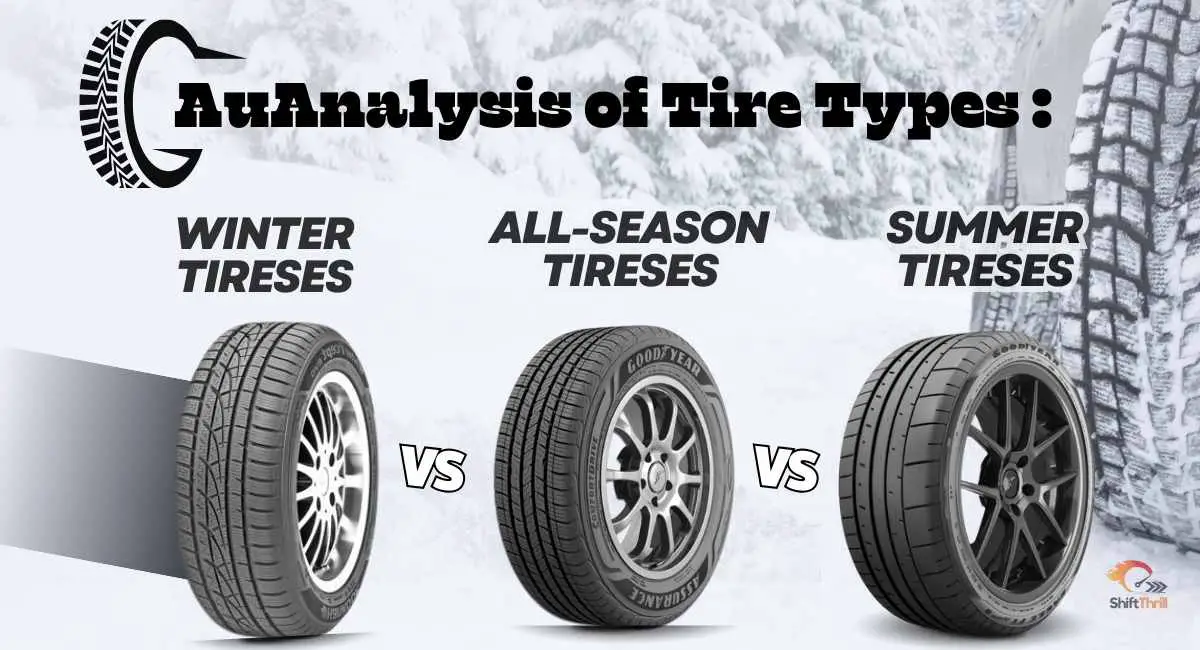Tires can be costly, especially with seasonal changes. They are vital in connecting your car to the road, absorbing vibrations, and supporting its weight while transmitting traction and braking forces. Selecting the proper tires is essential for performance, safety, and cost-efficiency.
Summer tires excel in hot, dry conditions, providing excellent grip on smooth roads. Winter tires offer superior traction on packed snow, ideal for cold, snowy weather. All-season tires are versatile but perform best on dry pavement, with reduced effectiveness in snow and wet conditions.
Understanding your needs is critical when choosing between tire types. Let’s compare All-Season, Summer, and Winter tires, considering their construction, tread patterns, performance in different weather conditions, longevity, wear, and cost-effectiveness.
What are the Construction and Tread Patterns of Tires?
All-season, winter, and summer tires are designed to suit different driving needs and preferences, depending on the weather and road conditions. Here are some of the main differences between them:
All-Season Tires
These tires have a balanced performance in warm and cool climates and wet and dry conditions. They are versatile and convenient, as you can use them all year round without changing. However, they are not ideal for extreme conditions like heavy snow, ice, or high temperatures.
All-season tires have a moderate tread depth and a slightly harder compound than winter tires, making them more durable, fuel-efficient, less flexible, and grippy. They also have several solid tread blocks arranged in a chevron-like pattern, which helps with stability and water evacuation.
Winter Tire
These tires are best for cold weather conditions like snow, ice, and slush. They are intended for temperatures under 40 degrees Fahrenheit, as they have a softer compound that remains flexible and grippy in low temperatures. They also have a deeper tread depth and a more intricate tread pattern than other tires, which helps with traction and braking on snowy and icy roads. Winter tires have deep grooves for compacted snow, improving grip by creating snow-on-snow traction. They also have minor cuts or sipes on the tread blocks, which increase the number of biting edges and improve handling on slippery surfaces.
Summer Tires
These tires are handy in warm weather conditions and dry or wet roads. Their design provides maximum grip, handling, and a smooth and quiet ride. They are suitable for temperatures generally above 40 degrees Fahrenheit, as they have a sticky compound that enhances grip and braking performance on wet and dry surfaces. However, they may harden and lose traction in colder temperatures, increasing the risk of slipping or skidding.
Summer tires have a shallow tread depth and a more straightforward tread pattern than other tires, improving steering feel and responsiveness and reducing tread life. They also have a broad and continuous center channel that helps with stability and cornering and parallel grooves that help resist hydroplaning by evacuating water in wet conditions.
These are some main differences between all-season, winter, and summer tires. Each type of tire has advantages and disadvantages, so choosing the right one for your vehicle and driving conditions is crucial.

Performance Characteristics in Various Weather Conditions
All-season tires perform adequately in mild weather conditions, offering decent traction and handling on dry and wet roads. However, they may need help in extreme cold or heavy snow, lacking winter tires’ specialized tread patterns and rubber compounds.
Summer tires shine in warm and dry conditions, providing excellent grip and responsive handling. However, they are less effective in wet or cold weather, as their tread patterns and rubber compounds are not optimized for such conditions, leading to reduced traction and braking performance.
Winter tires are unbeatable in cold, snowy, and icy conditions, delivering superior traction and braking performance. They provide a confidence-inspiring grip on snow-covered roads, ensuring safer driving during the winter months. However, they may exhibit reduced performance and increased noise levels on dry pavement.
Longevity and Wear Patterns
All-season tires typically offer a balance of longevity and performance. With proper maintenance, they can last for tens of thousands of miles. Common wear patterns include even tread wear across the surface of the tire.
Summer tires have a shorter lifespan than all-season tires due to their softer rubber compounds and specialized tread designs. They may show accelerated wear, particularly on hot and abrasive surfaces.
Winter tires may experience faster wear on dry pavement due to their softer rubber compounds and aggressive tread patterns. However, you can extend their longevity by using them only during winter and storing them properly during the off-season.
Cost-Effectiveness Considerations
When considering the cost-effectiveness of tire options, weighing the initial investment against long-term savings is essential. All-season tires are often the most cost-effective choice for drivers who don’t experience extreme weather conditions regularly. They provide versatility and longevity, making them a practical option for many drivers.
Summer tires may offer superior performance in warm weather but require more frequent replacement due to their shorter lifespan. Drivers in regions with predominantly warm climates may find them to be a cost-effective choice for year-round use.
While essential for safe driving in cold climates, winter tires may incur additional costs for seasonal changes and storage. However, their improved safety and performance in winter conditions can outweigh these expenses for many drivers.
Comparative Analysis
When comparing the performance characteristics of All-Season, Summer, and Winter tires, several factors come into play:
- Traction and Grip: Winter tires offer the best traction on snow and ice, followed by All-Season and Summer tires. Summer tires provide the most grip in dry conditions, while Winter tires may feel less responsive.
- Handling and Stability: Summer tires excel in cornering and maneuverability on dry roads, while Winter tires prioritize stability and control in slippery conditions. All-season tires offer a compromise between the two, providing adequate handling in various weather conditions.
- Braking Performance: Winter tires deliver the shortest stopping distances on snow and ice, followed by All-Season and Summer tires. However, Summer tires outperform Winter tires in dry and wet braking tests.
- Noise and Comfort: All-season and Summer tires offer quieter and more comfortable rides than Winter tires, which may produce more road noise due to their aggressive tread patterns.
- Fuel Efficiency: All-season and Summer tires often provide better fuel efficiency than Winter tires, thanks to their lower rolling resistance. However, the difference in fuel consumption may be negligible for most drivers.
Factors Influencing Tire Choice
You should consider several factors when choosing the right tires for your vehicle:
Climate and Weather Conditions
Drivers in regions with mild climates may find All-Season tires sufficient for year-round use. However, those living in areas with extreme weather conditions may benefit from switching between Summer and Winter tires seasonally.
Driving Habits and Preferences
Enthusiastic drivers who prioritize performance may opt for Summer tires, while safety-conscious drivers may prefer the added traction of Winter tires during the colder months.
Vehicle Type and Usage
Your vehicle type, typical driving habits, and usage patterns can influence your tire choice. For example, SUV owners may opt for all-season tires with off-road capabilities, while sports car enthusiasts may prefer high-performance Summer tires.
Budget Constraints
While initial cost is a consideration, evaluating the long-term value of your tire investment is essential. Cheaper tires may save money upfront but could cost more in the long run if they require frequent replacement.
What is the Lifespan of Different Types of Tires?
The lifespan of different types of tires depends on various factors, such as the tire design, the driving style, the road conditions, the weather, and the maintenance.
According to some sources, the average tire can last between three and five years, or between 30,000 and 60,000 miles, before needing to be replaced. However, some tires may last longer or shorter than others, depending on their specific features and usage.
Some of the main types of tires and their approximate lifespans are:
For instance, all-season tires can last up to 60,000 miles or more, depending on the quality and the warranty. Winter tires can last up to 20,000 miles, depending on how often and long you use them. Summer tires can last up to 25,000 miles, depending on the driving style and the road conditions.
These are some of the approximate lifespans of different types of tires. Still, they may vary depending on the specific brand, model, and quality of the tire, as well as the driving habits and preferences of the driver.
But what if you want to extend the life of your tires? It is wise to regularly check their tread depth, pressure, balance, alignment, and rotation and follow the manufacturer’s instructions and recommendations.
It is also essential to replace your tires when they reach the wear bars at 2/32 of an inch or when they show signs of aging, cracking, or damage, regardless of the mileage or the warranty. Driving on worn or aged tires can compromise safety and performance and increase fuel consumption and emissions. According to the National Highway Traffic Safety Administration, worn tires have three times more chance of causing accidents.
How to Check the Tread Depth of All Types of Tires
Now that you know how long your tires may last, how about how to check and confirm the tread depth before changing? Well, there are several methods to check the tread depth of your tires, such as using a coin, a tread depth gauge, or the tread wear indicators on your tires. Here are some brief explanations of each method:
Coin Test
You can use a coin, such as a penny or a quarter, to measure the tread depth by inserting it into the tire groove. If the tread does not cover the head of the coin, your tire has less than 2/32 inches of tread depth, which is the minimum legal limit in most states.
Tread Depth Gauge
You can use a tread depth to measure depth on tires. You can buy a tool at auto parts stores to measure the tread depth in 32nds of an inch or millimeters. You need to insert the gauge probe into the tire groove and read the measurement on the cylinder.
Tread Wear Indicators
You can also check the tread wear indicators and rubber bars embedded in the tire grooves. They are 2/32 inch high, the same as the minimum tread depth. Replace your tire if the tread is level with the indicators.
You should check the tread depth at different points around the tire, as the wear may not be even. You should also check the tire pressure, alignment, and rotation regularly to extend the life of your tires and ensure your safety.
Maintenance Recommendations
Maintaining your tires is crucial for maximizing their lifespan and performance.
So,
- Regularly check tire pressure and ensure proper inflation according to the manufacturer’s recommendations.
- Rotate your tires often to promote even wear and extend their lifespan.
- Keep your wheels aligned to prevent uneven tire wear and maintain vehicle stability.
- Store off-season tires away from direct sunlight to prevent damage and deterioration. Consider a cool, dry place.
Environmental Considerations
Tire production and disposal can have significant environmental impacts. For instance,
The production of tires requires resources and energy, contributing to carbon emissions and environmental degradation.
Proper tire disposal is essential to prevent pollution and habitat destruction. Many tire manufacturers offer recycling programs to reduce waste and promote sustainability.
Choosing eco-friendly tires, such as tires made from recycled materials or those with low rolling resistance, can help minimize your environmental footprint.
Conclusion
Before choosing the right tires for your car, consider factors like construction, tread patterns, performance, longevity, cost, and environmental impact. All-season, Summer, and Winter tires have strengths and weaknesses suited to different driving conditions. Understanding these features and your needs helps ensure optimal performance, safety, and value. Your tire choice significantly influences your driving experience and vehicle potential, whether you prioritize performance, safety, or cost-effectiveness. Consider these factors when selecting tires to make the best choice for your vehicle and driving preferences.
